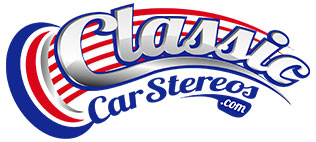Free Shipping*
Lower 48. Orders over $100.
2 Year Warranty
On all our radios.



Your cart is currently empty.

Adding an amplifier to your classic car stereo system will push more power and cleaner power to your speakers. Power is the answer for improved sound quality, volume, and clarity. Think of your stereo and speakers as a large rock. I might be able to bend over, reach down, and pick that heavy rock up. Or, I could have a crane pick up and move the rock. Me picking up the rock is the built-in power in your radio. The crane is the equivalent of using an amplifier.
Why You Need an Amplifier
Yes, we said, "Need." You should consider adding an amplifier to your classic car because it will create a significantly better driving experience. You just invested a significant amount of time and/or money into your classic car, and you can take your driving experience to the next level with a stereo system that sounds amazing. An amplifier may cost $200-$700. But, imagine this...
You are driving your car on a nice sunny day, the windows are down, and you have your favorite song playing. You turn it up because you like the song, and the more you turn it up, the better it sounds. It actually sounds so good, you think that they are playing the song right there for you, and you can't help but smile and maybe turn it up a little bit more because it just sounds that good.
That's what an amplifier does. The stereo systems that come in new cars today sound pretty freakin' good and there is a reason for that. Most new cars that have come with a "Premium" or "Bose" or "Bowers and Wilkins" or B&O" or whatever name stereo system, sound incredible. You can have that sound quality and probably better in your classic car for usually less than $1000. When it comes to the cost of the car, it usually isn't that much in terms of a percentage. But, what you get in return is so so worth it. "Smiles per Mile"
There are some important steps to help you figure out which amplifier is right for you.
How Many Speakers are you Powering?
Most classic cars that have upgraded the stereo system have four speakers. There are typically two speakers in the front, either in the kick panels or in the dash location, and two speakers in the rear deck, typically 6x9s. If you have a truck, or if you have a coupe such as a Thunderbird or Corvette, you may have less than 4 speakers. Regardless, count the number of speakers in your vehicle.
Do you have or do you want a subwoofer?
If you have a subwoofer, or if you plan to add a subwoofer, you will need an amplifier to power it. Typically we power subwoofers with monoblock amplifiers or 5 channel amplifiers. The monoblock amps are amplifiers that are designed to specifically power subwoofers and 5 channel amplifiers allow you to power 4 channels and a subwoofer with a single amplifier.
What is the RMS power rating of the speakers and/or subwoofer?
When looking at the power rating on speakers, we only care about the RMS rating. Peak power handling is not important. If your speakers are rated at 75W RMS, you ideally want to be somewhat close to that. You will be fine with 45 watts of power and you will be fine with 100 watts RMS from your amp. If your speakers are rated at 75W RMS and your amp is putting out 100W RMS, you want to make sure that you don't have the gain turned up all the way.
Now that we have that info...
Amplifier Channels
Amplifier Brands
Keep It the Same as the Speakers
Don't make it more complicated than it needs to be. Unless you really know car audio amplifiers, the easiest thing to do is to use an amplifier from the same brand as your speakers. If you have Kicker speakers, go with a Kicker amplifier. The same thing holds true with Rockford Fosgate, JL Audio, Kenwood, etc.
Some Exceptions
The only exception to this rule is Hertz. The affordable Hertz amplifiers aren't that good. Hertz makes great speakers, but when it comes to amplifiers, go with the Audison SR series, Rockford, or JL Audio. JBL and Infinity amplifiers work fine, we probably like the Audison, Kicker, Rockford, Kenwood, and JL Audio amps better.
Frequency Ranges, Filters, and Crossovers
Amplifiers will have frequency ranges, filters, and crossover specifications that allow you to control which signals go to which speakers.
Frequency Range
Outside of monoblock amplifiers, two, three, four, and five-channel amplifiers will be able to power your speakers without having to worry about the frequency ranges. On 3 channel amplifiers and 5 channel amplifiers though, the subwoofer channels are designed to play subwoofer frequencies, typically below 200 Hz. You can't use the subwoofer channels on 3 and 5 channel amplifiers to effectively power and send the proper signal to full range speakers.
Filters
Crossover Slope
The crossover slope is typically shown as 12 dB/octave or 24 dB/octave. This number tells you the slope of the fall-off at the crossover point. If we have the crossover set at 80 Hz, a 24 dB/octave crossover is going to "fall off" much faster than a 12 dB/octave crossover. Most amplifiers have 12 dB/octave crossovers and it is more than enough. Don't overthink this.
Product Recommendations
These are some of our favorite amplifiers that we offer
4 Channel Amplifiers
5 Channel Amplifiers
Mini Amplifiers
You can't go wrong with any of these products. They all sound great.
Copyright © 2025 ClassicCarStereos.com